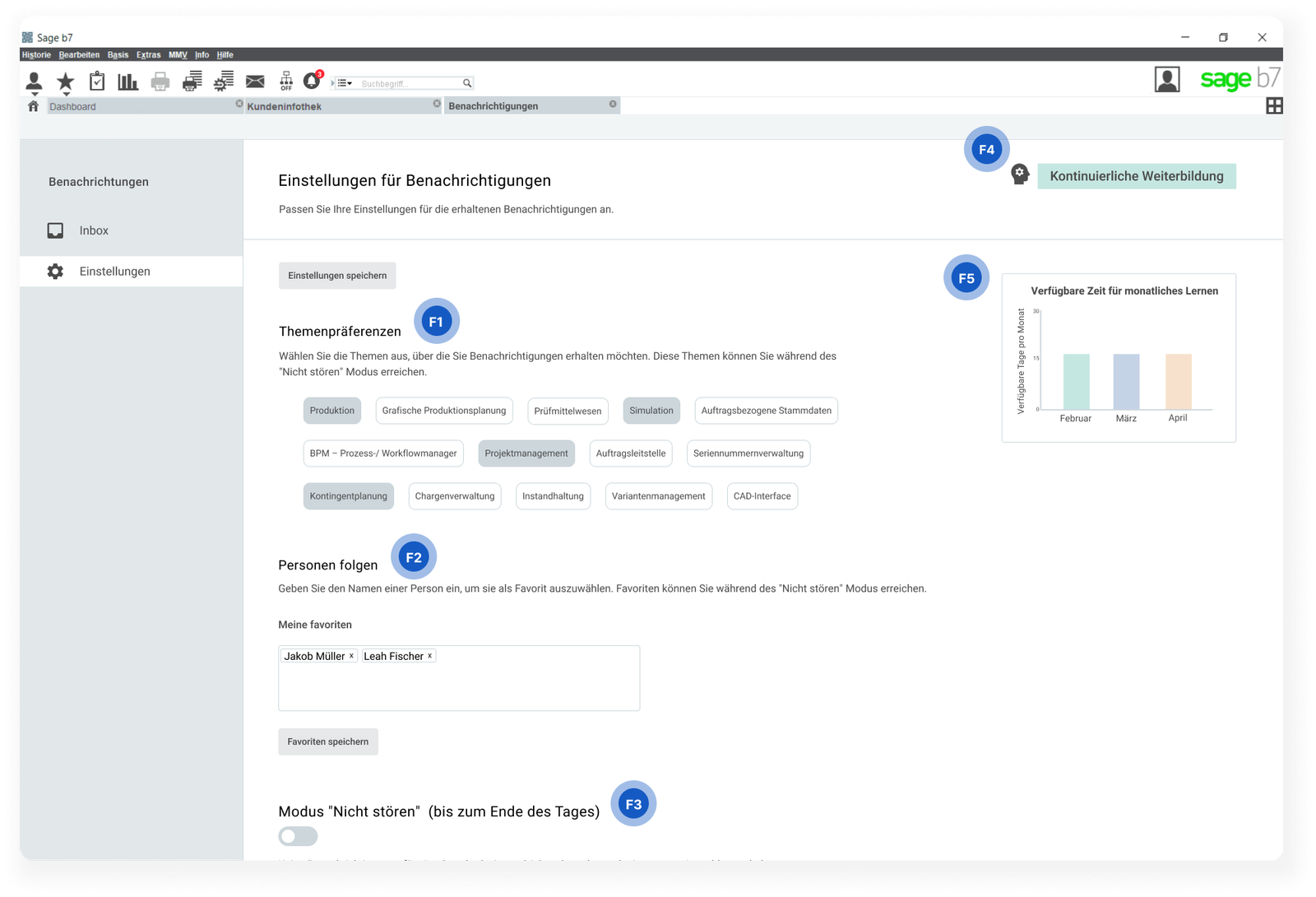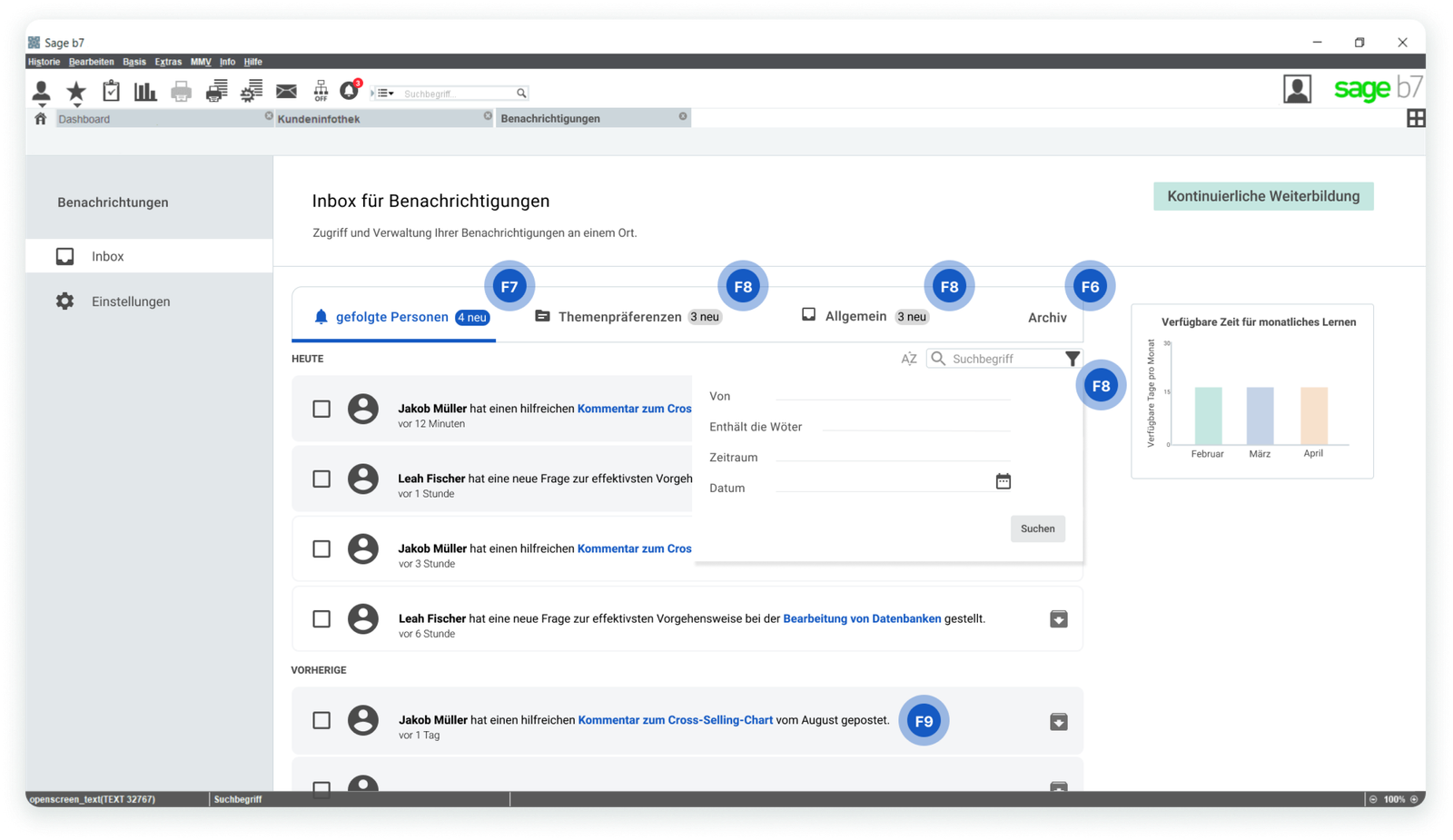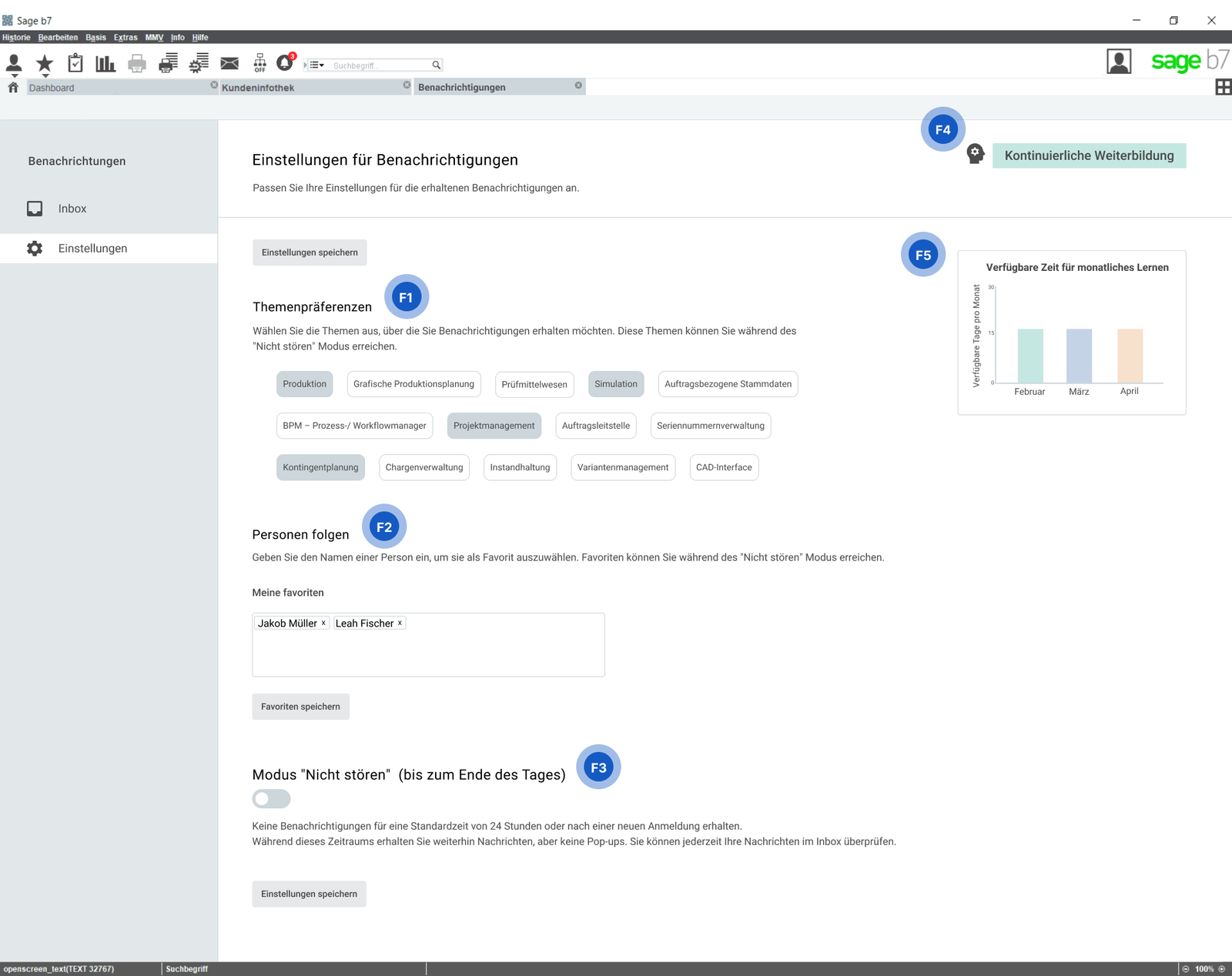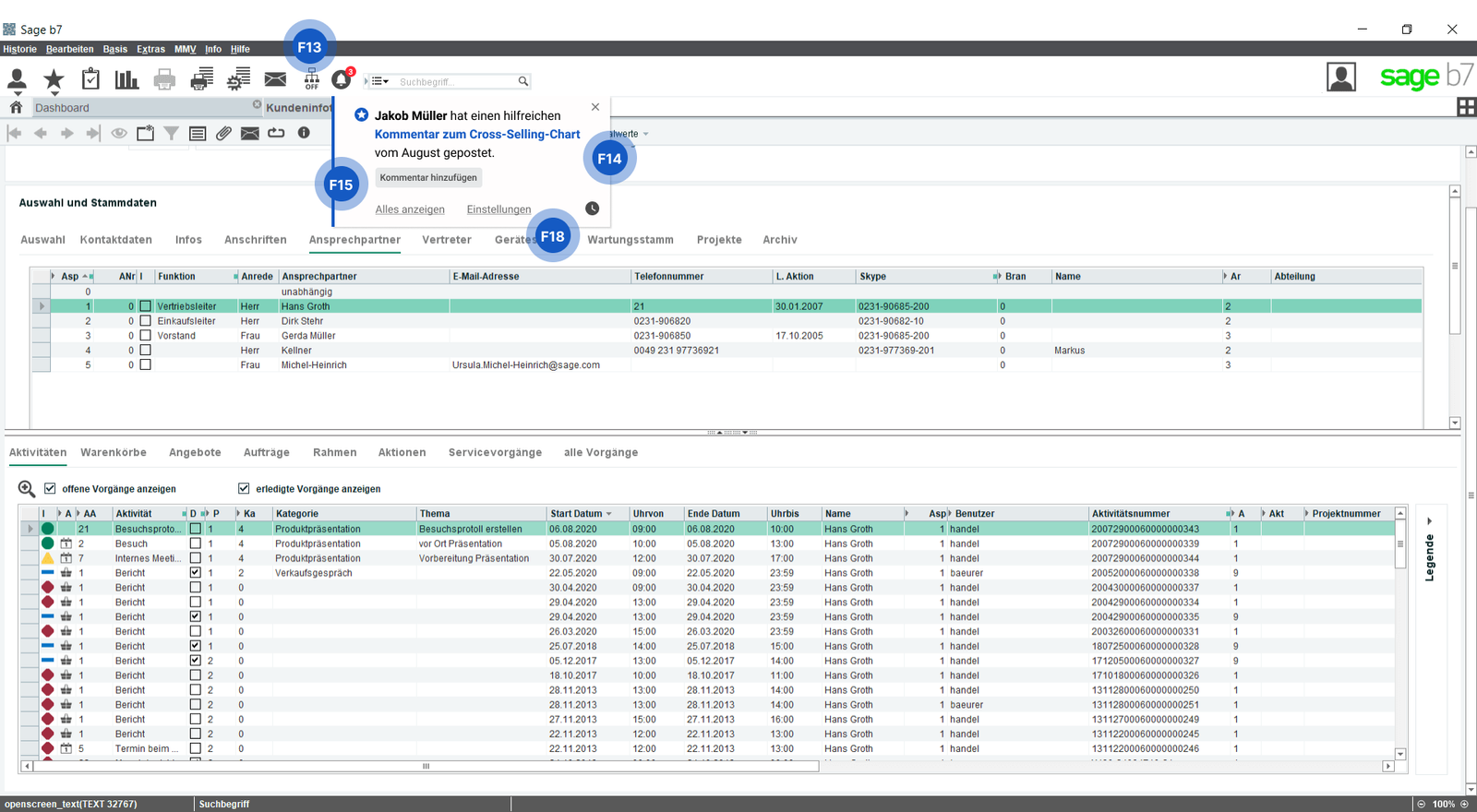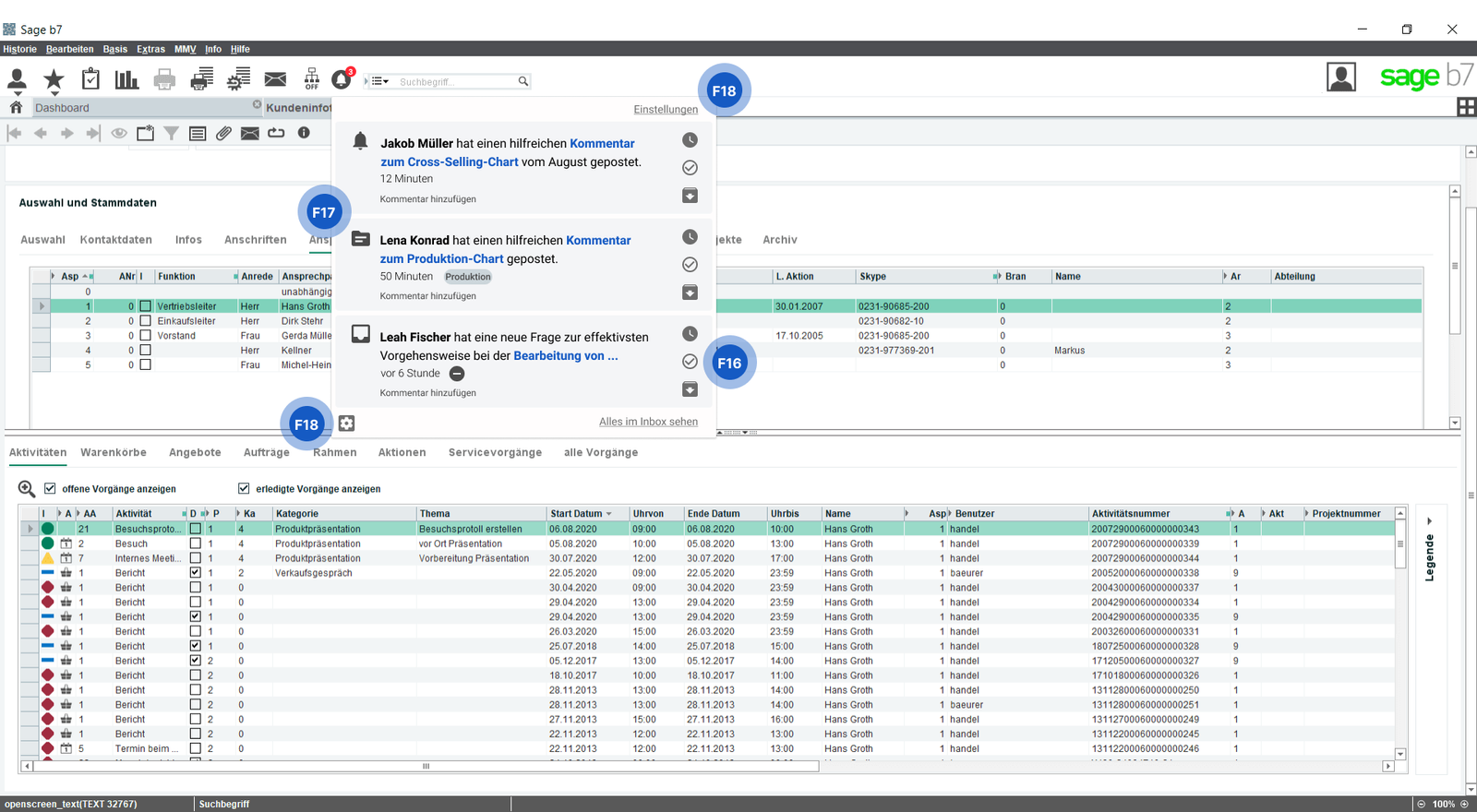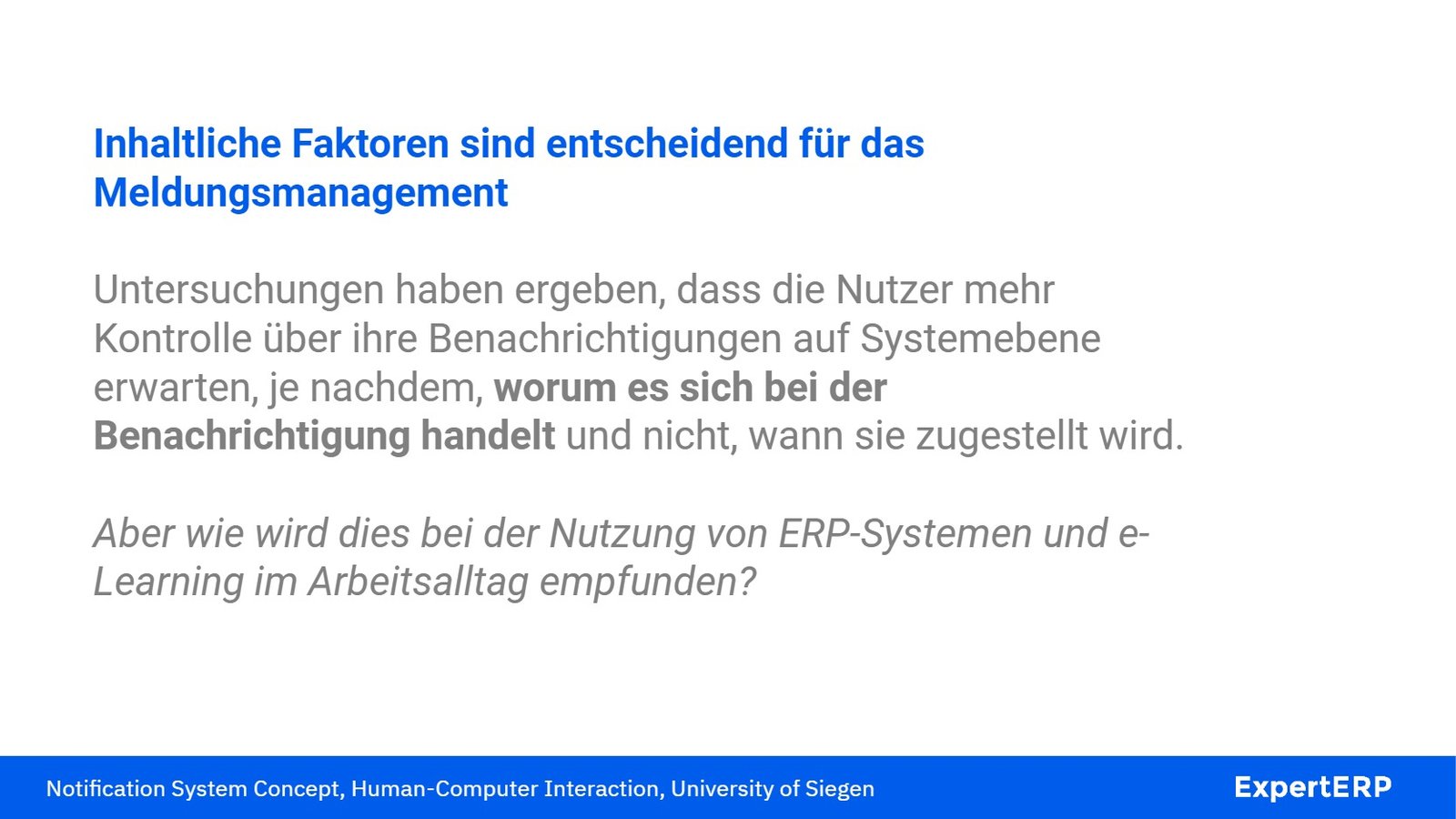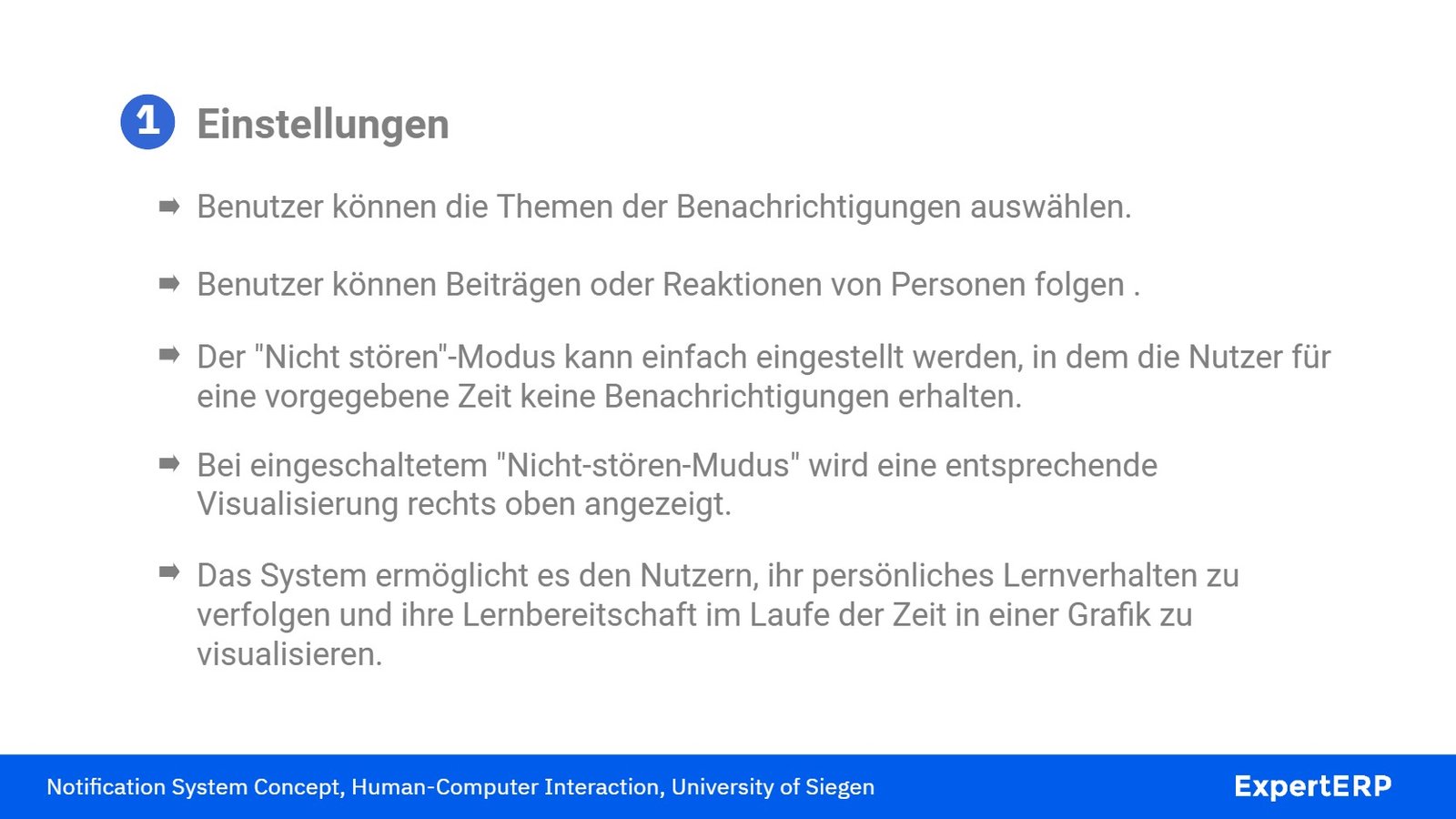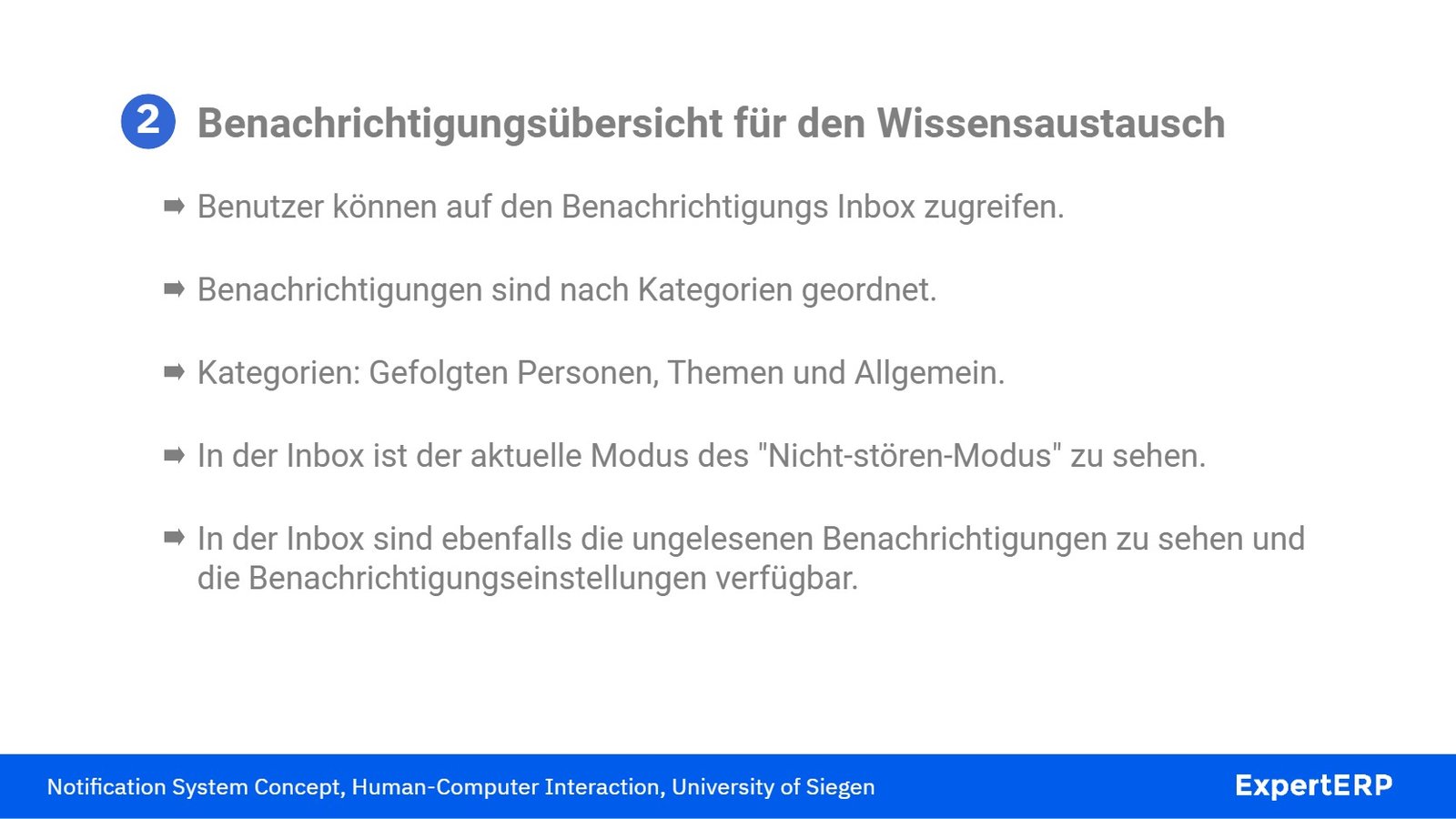Benachrichtigungssystem
Designkonzept für ERP
MEINE ROLLE
UX-Designer
UX-Researcher
UI-Designer
TOOLS
Figma
Zoom
Miro
MAXQDA
BESCHREIBUNG
Ein Konzept für ein Benachrichtigungssystem, das den Austausch von Fachwissen im Zusammenhang mit der Nutzung des ERP-Systems Sage B7 fördert.
PROJEKT-ZIEL
Hauptziel des Projektes war es, im Rahmen des vom Bundesministerium für Bildung und Forschung geförderten Projektes ExpertERP zu erforschen, wie ein Benachrichtigungssystem gestaltet werden kann, um den Austausch von Fachwissen im Zusammenhang mit der Nutzung des ERP-Systems Sage B7 zu fördern.
MEINE AUFGABEN
- Projektkonzeption auf Basis des gewählten Design Frameworks.
- Definition der Designprinzipien auf der Basis von Benchmarking und Best Practices.
- Erstellung von Konzept & User Flows.
- Erstellung von Klick-Prototypen in Figma.
- Gestaltung eines partizipativen Design-Workshops für ERP-Benutzer.
- Analyse der Workshop-Ergebnisse.
- Formulierung von Gestaltungsempfehlungen auf Basis der Ergebnisse der Nutzerforschung.
Best practices
Project Phases
Design Principles
To gain inspiration to design an interaction concept to study the dynamics of a notification system for the Sage B7 ERP system, I analyzed some of the design principles established in user studies and related products.
Events should be delivered to connected clients in a timely enough manner to support human-to-human interaction. (1)
The system should allow subscribers to request that a history of published events be kept in case they have been disconnected. (1)
Unification of all notifications relevant to the user, through a notification Inbox. All notifications (events, email, chats) (1)
The visual design supports the user. Link highlighting between the events allows the user to see where his/her specific events are found. (2)
Visualizations of the user’s notification usage data. (3)
Personalized suggestions for notification management. (3)
Users can delete notifications or move them individually to Current Todo or Future Todo areas. (2)
Notifications are automatically grouped. All events relating to a particular work item appear together. Additional filters/sorting is available. (2)
A small amount of automated assistance is provided. For example, automated responses are sent to the notification sender. (2)
Easy independent personalization such as directly linking the visualizations to manual notification personalization. (3)
To maintain activity awareness it is important to convey an understanding of the purpose and meaning of the information rather than just the information itself.” (4)
(1) L. F. Cabrera., et al., (2001)
(2) Mcgrenere, et al., (2010)
(3) Janzen and McGrenere, (2022)
(4) John M. Carroll., et al., (2003)
Project plan
Project Phases
Context
I developed this project during the second semester of my master in Human-Computer Interaction at Universität Siegen under the chair of CSCW and Social Media. I worked specifically within the project ExpertERP.
The project Expert ERP is funded by the Federal Ministry of Education and Research of Germany (BMBF) and aims to “create sustainable structures for ERP use with a high level of functionality in order to optimally support digital and analog business processes, especially during the multi-year use phase.”
ExpertERP gathers a group of actors to establish a consortium to “research in practice how users acquire ERP systems, i.e. make them usable for their own work practice. As well as, sharing expertise to improve knowledge transfer when using ERP systems from SMEs for SMEs.” (ExpertERP, 2022)




Design Framework
The framework that guided my design process was the Design Case Study by Wulf et al., (2015) which encompasses three main phases, the Pre-Study, Design Phase, and Appropriation and Evaluation Studies.
I developed this project within the Design Phase, because my intention was to apply technological options to a context-specific problem by means of participatory approaches.
PRE-STUDY
An initial understanding of existing technological and organizational practices, and social perspectives is accomplished through means of ethnographic methods, to identify problems, needs, and opportunities.
DESIGN
The application of technological options to a context-specific problem, need, or opportunity is achieved by participatory approaches such as participatory design, usability tests, and design iterations.
APPROPRIATION STUDY
The purpose in the phase is capturing the long-term effects of IT artifacts in specific contexts through reflection with practitioners, repeated study, and joint work with pre-study efforts.
Project Stages
In this case, I followed a four-stage process.
1
First, I conducted a literature study to learn about notification systems, and awareness, according to the CSCW research group. Additionally, I had an advisory session with two experts in ERP Systems, who provided me with valuable insights for the design phase.
2
Secondly, I designed an interaction concept to study the dynamics of a notification system for an ERP system based on the research findings and design principles analyzed in the literature review phase.
3
Next, I carried out the empirical work with context-related participants. I designed a workshop to foster discussion and receive feedback on the design concept of the notification system.
4
Finally, I conducted a thematic analysis of the data gathered in the previous stage and then a requirements elicitation process to establish recommendations for design.
Design Concept
Project Phases
4. Don’t disturb mode demonstrator
5. Notifications visualization
Features definition
After analyzing the research findings and design principles presented in the eight user studies, I worked on the compilation of a set of design principles and feature requirements to design a notification system concept to support expertise-sharing within the Sage B7 ERP System.
All in all, I got to 10 design principles and 18 feature requirements distributed in four different user flows.
🔹Settings customization
🔹Inbox management
🔹Don’t disturb mode demonstrator
🔹Notifications visualization.
Below, I present the design principles and feature requirements according to the referents for each user flow, in addition to the corresponding screens where specific features are illustrated.
Settings customization
Features
DF1: Users can set their preferences. (content-based classifiers)
(Tianshi Li., et al., 2022)
DF2: Users can follow other users.
(ERP expert researchers’ contribution)
DF3: Users can easily set the “do not disturb mode” (ERP expert researchers’ contribution)
DF4: Users see a tag of the notifications corresponding mode on top of the notifications hub.
DF5: The system allows users to track their personal learning behavior related to knowledge-sharing notifications. (Tianshi Li., et al., 2022)
Inbox management
Features
DF6: Users can archive notifications. (Mcgrenere, Joanna., et al., 2010)
DF7: Users can access the Notification inbox. (ERP expert researchers’ contribution)
DF8: Notifications are automatically grouped, filters/sorting is available. (Mcgrenere, Joanna., et al., 2010)
DF9: Link highlighting between the events in the Notification Hub. (Mcgrenere, Joanna., et al., 2010)
Don’t disturb mode
Features
DF10: DND mode is turned off after a day (24 hours) or after the new login. (ERP expert researchers’ contribution)
DF11: People or topics that were marked as favorites can reach users during the “don’t disturb mode” (ERP expert researchers’ contribution)
DF12: Blinking Notification bubbles make silenced notifications visually salient. (Mcgrenere, Joanna., et al., 2010)
Notifications visualization
Features
DF13: The system notifies users who are interested in specific learning topics. (Mcgrenere, Joanna., et al., 2010)
DF14: The notification provides a short and concise explanation of the importance of its content.
DF15: The notification modal provides users with a button to open a text box.
DF16: The notification modal informs users of the action options, and provides them from the same interface with advanced information/button options to take action.
DF17: Color coding/icons of events by type support easy scanning on notifications visualization. (Mcgrenere, Joanna., et al., 2010)
DF18: Users can reach the notifications settings panel by clicking a link from where any notifications emerged. (Janzen and McGrenere, 2022)
User research
Project Phases
2. Workshop design and execution
Data Collection
I conducted empirical qualitative work through the development of one participatory workshop. I collected data on the feedback and discussion fostered by the presentation of the design concept explained above. The two main data collection sources were the workshop activities responses on a Miro board and the open discussions fostered during the two hours of online workshop, which was recorded for further analysis.
The overall project objective, “To research how a notification system can be designed to support Expertise Sharing in the context of the use of an ERP System,” and the research questions worked as guidelines for the workshops’ design, development, and analysis.
The workshop agenda encompassed the following points:
🔹Definition of notifications
🔹Best practices for the design of notification
🔹Introduction of the design concept
🔹Workshop activities
Workshop design and execution
Participants
The workshop had a total of 7 participants, who were users and consultants of ERP Systems actively working at Getränke Degenhart e.K., Bruse GmbH & Co. KG., Aventum, and .dicomputer in the Siegerland region of Germany. The workshops were conducted in German by a moderator.
To begin with, a brief introduction was provided on the definition of notifications, with the aim of familiarizing the workshop participants with the main concept that would be explored.
The second stage involved a brief presentation on the best practices for designing notifications, as outlined in the literature. Additionally, the participants were provided with some reflection questions to encourage their active engagement with the topic
At the third point the interaction concept was introduced to the workshop participants.
The participants were then engaged in a series of activities distributed across four workspaces, with a moderator guiding the different activities and fostering discussion and opinion exchange after each one. The workshop was divided as follows:
🔸Workspace 01 – Notifications settings and contained a video prototype for participants to observe intended user interaction in the target flow, one voting activity, and four open-ended questions.
🔸Workspace 02 – Notifications inbox and included one video prototype and four open-ended questions.
🔸Workspace 03 – Notifications visualization and again featured a video prototype and five open-ended questions.
🔸Workspace 04 – Don’t Disturb mode demonstration and included a video prototype, one voting activity, and three open-ended questions.
To allow for flexibility and address the research questions most relevant to the participants, some activities were marked as optional due to time constraints.
Video Prototypes
In each workspace, I included a video prototype for the participants to observe the intended user interaction in each user flow.
https://www.youtube.com/watch?v=fitLr_XFKnU
Notifications settings
How to configure notification preferences by selecting topics of interest and people to follow as favorites, activating “do not disturb” mode, and viewing a graph of learning time per month.
https://www.youtube.com/watch?v=0t0ZLe4Qsms
Inbox management
Notifications in the inbox are organized into tabs: “followed people” and “theme preferences.” The general tab includes all learning notifications with options for filtering by “do not disturb” mode, date, sender, and a keyword search.
https://www.youtube.com/watch?v=y5VHQN4-Xfg
Notifications visualization
How the receipt of a notification is displayed and the possibilities of interaction with it. It shows a pop-up next to the notification icon that appears and disappears automatically after a few seconds.
https://www.youtube.com/watch?v=aXF2Gto8jGk
Don’t disturb mode
In “Do Not Disturb” mode, notifications are suppressed, and pop-ups don’t appear. Instead, a red badge appears on the bell icon in the top bar to indicate new notifications. Only notifications from followed people and preferred topics are displayed.
Research findings
Project Phases
Data analysis
After conducting the workshop, I proceeded with the data analysis.
The whole data set was analyzed using the thematic analysis method by Braun and Clarke with the software MAXQDA.
During the data analysis I developed six themes with definitions, based on codes extracted from the data collected on the workshop.
- Knowledge-sharing interactions
- Notifications content
- Fostering long-term engagement
- Looking for the right timing for notifications
- Customization options that make sense
- Strategies to deliver highly personalized notifications
Research insights
I followed the requirements elicitation process based on these six themes, adhering to the Blending adaptation for requirements elicitation within stages of the Design Case Study by Syed H., et al. (2022)
During requirements elicitation, I identified six key user needs that would inform the potential design improvement of the proposed notification system for the Sage B7 ERP.
Requirement 01
The notification system should improve knowledge-sharing articulation work practices by fostering collaboration and knowledge exchange among team members.
Requirement 02
The system should notify users about job-related information that aligns with their specific interests and needs, while also minimizing cognitive load and avoiding negative impacts on productivity.
Requirement 03
The notification system should foster long-term user engagement to the knowledge-sharing dynamics within the ERP System.
Requirement 04
The notifications by the system should adjust to the users’ timing, the “don’t disturb mode” allow users to indicate to the system when to deliver notifications.
Requirement 05
The system should provide users with preference management options that suit their needs, ease the overall interaction and prevent negative effects on the workflow.
Requirement 06
Strategies to deliver highly personalized notifications should be enabled by the system.
